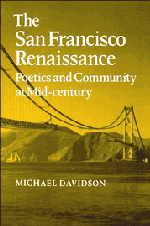3 - “Spotting That Design”
Incarnation and Interpretation in Gary Snyder and Philip Whalen
Published online by Cambridge University Press: 01 June 2011
Summary
FORMS OF SPIRITUAL PRACTICE
A popular misconception about the Beats is that they were dabblers in esoteric religion, turning to Zen, cabala, or activist versions of Catholicism in order to discover new spiritual highs. John Ciardi, writing in the Saturday Review in 1960, claims that the Beats have “raided from Zen whatever offered them an easy rationale for what they wanted to do in the first place,” and Herbert Gold, writing in Playboy, says that “Zen Buddhism has spread like Asian flu…. Zen and other religions surely have their beauties, but the hipster dives through them like a side show acrobat through a paper hoop.” Though it is certainly true that poets turned to alternative religious systems and practices during the 1950s and 1960s, it is demonstrably not true that this interest was in any way casual.
Consider the facts: Gary Snyder left San Francisco in 1955 to live in Japan on and off for the next twelve years while engaged in formal Zen training. During this time, under the tutelage of Roshi Oda Sesso, he took formal vows as a Zen monk. Allen Ginsberg has spent much of his time during the past fifteen years as a follower of Tibetan Buddhism, traveling extensively in India and the East as part of his spiritual training.
- Type
- Chapter
- Information
- The San Francisco RenaissancePoetics and Community at Mid-Century, pp. 95 - 124Publisher: Cambridge University PressPrint publication year: 1989



